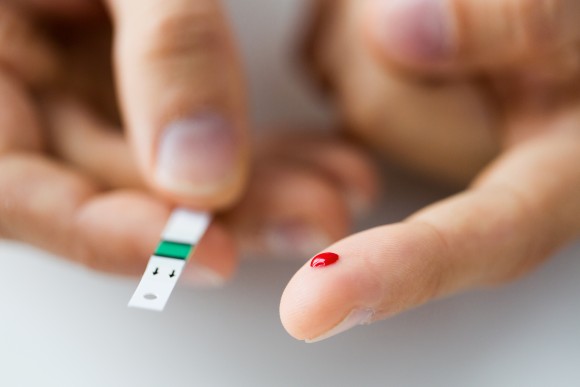The Hidden Epidemic of Early Diabetes
Distressed Patriotic Flag Unisex T-Shirt - Celebrate Comfort and Country $11.29 USD Get it here>>

Many people with high blood sugar levels are told by their doctors that they don’t have diabetes because their fasting blood sugar levels are normal. Normal is below 100 milligrams per decilitre (mg/dl).
But here is the problem: Early in the disease, diabetics often have a “normal” fasting blood sugar, yet one hour after they eat, their blood sugar levels rise above 140. This signals that they are at increased risk for heart attacks, strokes, cancers, nerve damage and premature death.
Not knowing that you have early diabetes is a real tragedy, because many cases can be cured with lifestyle changes.
Blood Sugar Levels Can Be Deceiving

Everybody’s blood sugar levels rise after they eat. But if blood sugar levels rise above 140 mg/dl after you eat, the sugar in the bloodstream can stick to the outer membranes of cells in your body. Once stuck on a cell, blood sugar cannot get off. It is eventually converted to sorbitol, which destroys that cell.
Recently, researchers showed that people whose blood sugar levels rise above 140 one hour after a meal, already have all the same markers of arteriosclerosis as proven diabetics; even though they may have normal fasting blood sugar levels, and a normal glucose tolerance test.
Another study followed people with blood sugar levels of 155 one hour after eating. It showed that they die significantly earlier than those whose blood sugar levels do not rise that high after food.
The American Association of Clinical Endocrinologists, composed of doctors who treat diabetics regularly, recommend that blood sugar levels not be allowed to rise above 140 mg/dl, two hours after a meal.
Having normal fasting blood sugar levels, but high blood sugar after meals is associated with increased risk of conditions such as diabetes, heart attacks, high blood pressure, cancer, strokes; even premature death.
Nerve Damage and High Blood Sugar

Having post-meal blood sugar levels above 140 mg/dL can also cause nerve damage. Many people who come to doctors with a loss of feeling, or severe pain, are not diagnosed as diabetic because their fasting blood sugar levels are below the “normal” 100.
For people who eat a typical Western diet, the most common cause of slow-healing wounds and nerve damage is diabetes. Doctors often fail to make this diagnosis. Instead, they prescribe drugs that can help to relieve pain, but they do not heal damaged nerves, and the drugs can cause horrible side effects. Early nerve damage caused by high blood sugar can often be reversed, just by keeping blood sugar in check.
When compared to people without nerve damage, those with nerve damage are far more likely to have blood sugar levels over 140 mg/dl an hour after eating. In one study, 56 percent of patients with nerve damage had high blood sugar levels above 140, two hours after eating. More than half of the patients with nerve damage caused by high blood sugar levels have normal fasting blood sugar levels, but high blood sugar after eating.
You can predict which people with nerve damage have high blood sugar levels after eating just by checking to see if they have increased amounts of fat stored in their belly. Keeping blood-sugar levels below 140 mg/dl an hour after eating can reverse many cases of nerve damage.
Warning Signs of Early Diabetes
If you have more than two of the following signs of diabetes, and your fasting blood sugar is “normal” (under 100), ask your doctor to check your blood sugar one hour after eating. If it is above 140, you are in the early stages of diabetes. This is a signal that you should change your lifestyle immediately before you suffer serious damage to your health or even death.
There are many signs to look out for that indicate you are at increased risk for diabetes:
Medical Indicators
- Systolic blood pressure above 120 at bedtime
- Fasting blood sugar above 100
- Blood sugar over 140 two hours after eating
- Triglycerides over 150 mg/dL
- Good HDL Cholesterol less than 45
- Store fat primarily in the belly, rather than the hips
- Have a fatty liver
- Have small particle HDL and LDL cholesterol
Physical Indicators
- Pinch more than three inches of fat near your belly button
- Have small buttocks
- Have a family history of diabetes
- Are overweight
- Have small muscles
- In women, excess hair on the face or body, or have diabetes during pregnancy
- In men, a thick neck or male pattern baldness
Lifestyle Indicators
- Smoke
- Have more than one alcoholic drink a day or binge drink
- Do not exercise
There are also many symptoms of diabetes that should trigger you to investigate further. Some common symptoms are: frequent urinating or defecating; eating all the time and still feeling hungry; being thirsty; feeling tired; losing weight without trying; genital itching or fungus infections; wounds that do not heal; blurred vision.
See your doctor if you experience these symptoms. Early diabetes detection, and making key lifestyle changes, will give you a good chance of reversing the disease and changing your life.
This article was originally published on DrMirkin.com. Subscribe to his free weekly Fitness & Health newsletter.




